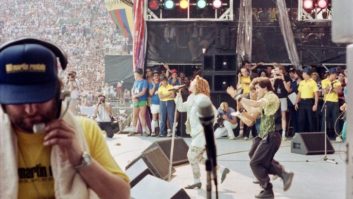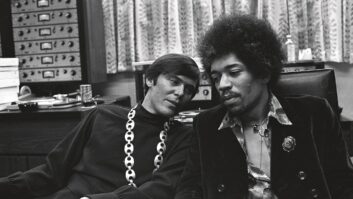We all love free stuff, and our search for it often leads us toexpend more energy than what the freebie is actually worth. However,that doesn’t stop us from prowling tradeshow aisles, stuffing our bagsfull o’ swag and filling our local disks with downloads. For those ofus with student IDs or anyone with more time than money and an aversionto the high total cost of ownership of commercial UNIX releases, not tomention the pain and suffering associated with Microsoft’s middlingmerchandise, there’s a particularly attractive download: Open SourceSoftware.
Bloat-free and, in many cases, cost-free, OSS is highly configurableand, most important, restriction-free, so no suit can tell you tomorrowwhat to do with your stuff…and what stuff! Everything frommultichannel DAWs to streaming audio servers and TiVO workalikes— if you can think of building it with a computer, someone’sprobably already done it with Open Source.
Let’s start with: “What is ‘Open Source’?”Think of Open Source as a variant of shareware, where“payment” comprises releasing any bug fixes andimprovements back into the public user/developer community at large.There are variations on this theme but that’s the basic idea. So, anymotivated individual can contribute to the product’s development andcan inspect all aspects of the underlying code, which is not possiblewith most commercial products. Not only is Open Source largely free, interms of purchase cost, but it relies on a volunteer developmentcommunity’s willingness to share all improvements to the code with therest of the world. This development-by-peer effort, where the guts ofthe machine are “open” and available for all to see, iswhat makes Open Source Software attractive to most users.
GNU (pronounced “guh-NEW”), a bellwether example of themany Open Source cooperatives, has a nice definition of OSS. Theofficial GNU Website (www.gnu.org) quickly points out members’ basicarticle of faith: “The GNU Project was launched in 1984 todevelop a complete Unix-like operating system, which is freesoftware.”
Notice the “Unix-like”: UNIX, an in-house projectwritten to run Bell System’s telephone service, spawned the Open Sourcemovement when Bell Labs distributed the original code to severalentities, including Sun Microsystems, UC Berkeley and Silicon Graphics(SGI). Sun developed its copy into Solaris, a successful enterpriseversion, while SGI, relying primarily on government contracts, hasn’tfared quite as well with its version, IRIX. The folks at Berkeleycreated the highly successful Berkeley Standard Distribution of UNIXadd-ons, which, in turn, evolved into the BSD family of UNIX.
The GNU site continues: “‘Free software’ is amatter of liberty, not price. To understand the concept, you shouldthink of ‘free’ as in ‘free speech,’ not as in‘free beer.’” Dammit, though, I like the concept offree beer! Anyway, a few thoughts from the development community helpto illuminate the underlying libertarian philosophy. WilfredoSánchez Vega, contributor to the Darwin BSD project, member of theApache Software Foundation and developer community manager at KnowNow,spoke at the 2002 O’Reilly OS X Conference. “Open developmentbuys you an ongoing win,” he said. “The community is moreimportant than the code: Code follows community. Actively exchangingcode provides better code review [which results in] increased quality,bug fixes from the community, new features from the community and waybetter standards compliance.”
He further offers this subtle equation: Open Source code + opendiscussions + an open process = open development.
To add to this freewheeling fracas, there are also commercial OSScompanies that sell complete systems, as well as software add-ons,professional services and support for their OSS offerings. Red Hat, abrand you may recognize, is a good example. Another commercial OSScompany you should know is Apple Computer and its Darwin project, whichis the Open Source heart of Mac OS X.
Open Source, particularly Linux, has caught the attention of theenterprise-computing community because of its transparency and lowentry cost. Linux is an Open Source operating system — modeled onUNIX — that combines the geekiness and almost infiniteadjustability of real UNIX with all of the user-interfaceidiosyncrasies you’d expect from Windows, driven by a worldwidecommunity of zealots as rabid as any Macintosh user group. Thevenerable IBM, once a bastion of proprietary product, has become thechampion of business applications for Linux. What’s less well known isthat there is a community of hobbyists and professionals who work,often without pay, to extend the less-expected capabilities of OpenSource operating systems, including audio services. Favoritedistributions are market leader Red Hat guys, and Mandrake and SuSELinux (pronounced “SUZ-eh”), two excellent Euro-contenders.Mandrake rocks if you’re using Linux in a server application, whileSuSE has a desktop version that’s perfect as a generic Windows desktopworkalike. SuSE Linux Desktop, a commercial product (it’ll cost youreal dollars), ships with a year of basic support, a nice touch forLinux newbies.
Linux, Linux, Linux — that happy, pudgy penguin pops up in themost unlikely places, even appearing stenciled on the sidewalks of MyFair City. Big Blue got fined for that stunt. What began as “justa hobby” for Finnish grad student Linus Torvalds has blossomedinto a growing wave of work around the globe for companies that are fedup with the high cost of licensing and administering commercialsoftware distributions. Fast, stable and moderately secure, that’s thegoods you buy into with Linux. Oh yeah, cost of acquisition is muchless expensive than Windows and commercial, enterprise versions ofUNIX. By the way, Mandrake is the most mouse-friendly, GUI-driven ofthe Linux lot.
Equally beefy, but less well-publicized, is NetBSD, an open versionof one of the two “forks” of Bell Labs’ original UNIX. Inall, there are four Open Source BSDs available: FreeBSD, NetBSD,OpenBSD and Darwin. BSD is far more mature than Linux, and arguably themost secure flavor of open UNIX out there. In addition, BSD is stable,a miserly user of memory and free of recent legal wranglings brought onby SCO (the owner of System V), the other fork of the original UNIX.The word fork is used, in this case, to describe the process ofsplitting software into two or more separate development paths. BSD andSystem V were the original two branches of UNIX that“forked” off the original UNIX distribution. Both are usedprimarily to host applications such as Web, database andbusiness-software servers.
Although BSD and Linux run on everything from PDAs, Amigas and NeXTcubes to Sun pizza boxes, Sega Dreamcasts and Sony PlayStations, a goodway to get into Open Source is to dig up a retired Win box or Macclone, low-level-format the disk and install a copy of open BSD orLinux. Heck, the folks at SuSE offer a free, low-impact, bootable“live demo” disc image. Burn a CD, pop that disc in yourWin box, boot up and drive around SuSE without even installing it onyour local disk.
My mom, bless her heart, tends to see issues as black or white, and,being my mother’s son, I’ve gone that route and painted a fairly rosypicture of OSS. However, all is not sweet and light. Sánchez Vega,speaking of Darwin, concludes that, for most programmers,“Contributing is simply way too hard.” Turf wars andrivalries, hidden agendas and good old inertia affect OSS just as theydo in the world of “mainstream,” commercial softwaredevelopment.
Enough of politics, what can you do with this stuff? We’llexplore that aspect of OSS next time ’round, but, suffice to say, ifyou can think of building it with a computer, someone’s done it withLinux: TiVO workalikes to DAWs, we’ll look at it all. So, until nexttime, keep on tweakin’!
This epic column, over a year in the making, was written whileunder the influence of James Nichols’ special mix of DukeEllington’s The Far East Suite and Beck’s Sea Change. Fortechy advice, links and back issues of “Bitstream,” head onover towww.seneschal.net.
Darwin and the BFD About BSD
I mentioned that BSD is free of recent legal wranglings brought onby SCO, the owner of the System V fork. I’ll get into the whole SCOjive move next month, but for now, let’s focus on the other fork ofUNIX, the stable, secure Berkeley Standard Distribution. Long beforeLinux was the OS of the moment, BSD was workin’ its butt off. Accordingto Netcraft, 100% of the Web servers with the longest time betweenreboots use SD as their operating system, and 97% of those BSD serversare running Apache, the Open Source Web server application of choicethe world over.
Also mentioned earlier is Darwin, the free Open Source basis of MacOS. It came into being when Apple realized that it needed some seriousViagra for the aging Macintosh “Classic” operating system.NeXT OS, the core of Steve Jobs’ black, cubic vision of anext-generation computer he created after leaving Apple, morphed intoMac OS X, and for its “kernel,” or core operating system,BSD was chosen as the foundation. Apple released that kernel into theOpen Source community as the Darwin project, allowing“…developers to customize and enhance key Applesoftware.”
— Omas







